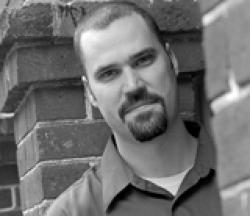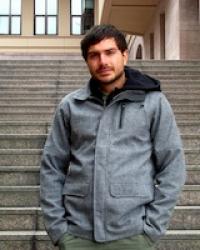
- A child holds her pet badger on the playground of the Chernigovsky block of Slavutych, a city erected by the late Soviet government to house the plant workers and their families after the Chernobyl disaster. (By Maisie Crow)
Twenty years ago, the most grandiose political and social experiment of the twentieth century, the Union of Soviet Socialist Republics, came to an end. It was a slow and painful death; there was no Soviet 9/11, no sudden implosion of illusions amid smoke and rubble. When the Belavezha Accords, formally dissolving the Union, were signed in a primeval forest in Belarus on December 8, 1991, the gesture was merely symbolic, acknowledging what the Soviet leadership had known, though refused to believe, all along: that the country was fiscally and ideologically bankrupt, that after more than seventy years of building the bright future of Communism, there were only dilapidated factories and cities with bleak concrete apartment blocks, where nobody wanted to live.
If there was one defining event, however, that precipitated the disintegration of the Soviet Empire, it was the nuclear meltdown at Chernobyl, the effects of which can still be felt in most of Eastern Europe twenty-five years later. The brave efforts of environmental groups to puncture the official silence surrounding the disaster was what led, indirectly, to the birth of glasnost during Gorbachev’s tenure and the collapse of the totalitarian containment vessel. There is no doubt that Chernobyl, for all its tragedy, freed millions of people and gave them the right to travel beyond the borders of the permissible.
Today, looking back at those events, it is hard not to feel a tinge of sadness. The dreams of a better world, liberated from the shackles of ideology, have come to naught. Liberal markets did not provide a solution to the problems of the Soviet Union, as greedy Communist Party officials and dodgy state-security agents simply privatized their official assets and power. Except for the Baltic countries—Lithuania, Latvia, and Estonia, which recently joined the European Union and now enjoy a level of relative prosperity— the ex-Soviet republics, including Russia, have been mired in poverty and corruption, violent social conflicts, environmental degradation, and political repressions.
Indeed, if there is a mood that hangs over all the essays in this issue, it’s the specter of that disenchantment. People who grew up in the Soviet era were raised on a diet of lies, and, even now, many struggle to divide old state-authored deceptions from genuine history. That past is clouded further by the haze of nostalgia and the natural human wish to salvage meaning from an era of repression and atrocities. Among the younger generation, many are still straining to find a voice that is more than opposition to the past—particularly because that past, as embodied by the Chernobyl era and its lies, is, increasingly, one they do not remember first-hand.
In April, Maria P. Vassileva and Maisie Crow traveled together to the northern Ukrainian town of Slavutych—a community erected to house the Chernobyl plant workers and their families evacuated from Pripyat. Vassileva and Crow arrived just days before the twenty-fifth anniversary of the disaster but found deep ambivalence about how to commemorate the date. Those who worked as “liquidators”—members of the clean-up crew that ventured into the fourth reactor—have a strong desire to be remembered and honored by the younger generation. Those who continue to work in the reopened plant, however, prefer not to think about the risks. For them, it is better to forget; only by forgetting do they have the courage to move on.

- Workers at the reopened Chernobyl plant go for regular check-ups to monitor their health. (By Maisie Crow)
Indeed, for many Ukrainians, the memory of Chernobyl has grown into a paralyzing national terror of radiation. That fear, however, also led to the closure of nuclear facilities and gave rise to radiological storage complexes like the one visited by Steve Featherstone. The threat of these materials making their way onto the black market has fed the dark fears of the West, where the intelligence community worries about the prospect of a dirty bomb attack. But if loose nuclear material is most abundant in Ukraine, its citizens are also eager to cooperate with the efforts of the international community to dispose of these materials—in large part because Chernobyl, as Featherstone writes, “lingers in Ukraine’s consciousness like a radioactive cloud, burning into the country’s mind a regard for public safety that borders on paranoia.”
That paranoia becomes more comprehensible when we learn about the decades of atmospheric and underground nuclear detonations carried out at places like the Semipalatinsk Nuclear Polygon on the steppe of northeast Kazakhstan. For more than a generation, the Soviet army herded citizens to spots near the bomb site to test the effects of exposure, and in the process, as Ed Ou documents in his series of intimate and heartbreaking photographs, they created a whole population afflicted by disproportionate rates of birth defects and serious illnesses. Little wonder, then, that people who came of age under the Soviet regime retain a suspicion of their leaders and see the corrosion of nuclear radiation as a kind of physical manifestation of their misgivings.
In this same way, the Chernobyl disaster has long served as a means for protest movements in Belarus to muster political opposition to Alexander Lukashenko—often called Eastern Europe’s last dictator, a living vestige of the Soviet era. Belarusians well remember that Moscow chose to seed the nuclear cloud, in order to unleash poisonous rain on the cities and farms of their homeland, rather than allow the toxic fruits of deception to reach the Kremlin. The annual commemoration has become one of the few ways to express dissent in Belarus, but this year, for the first time since the country gained independence in 1991, no one stepped forward to lead the Chernobyl rally—so a new generation is using the power of social media and the non-violent ethic of flash-mobs to challenge the power of the former Soviet Union’s last dictatorship.
This quiet revolution is also happening in the more complex spaces of poetry—once the strongest instrument of political dissent for free-thinkers like Osip Mandelstam, Anna Akhmatova, and the young Joseph Brodsky. Poetry—and literature in general—was never just an art form in the Soviet Union. Heavily influenced by Romantic ideology, it exhibited the features of myth, of ritual, of destiny. Poets were priests and purveyors of national ideals, and their rhymed words were a serious affair, at times more important than those of the General Secretary of the Communist Party. The field of aesthetics was a true battlefield, where many were exiled or even lost their heads. The sacred utterance of poetry invested it with enormous cultural capital—a situation envied by many writers in the West—but that uncritical reverence also ossified its forms and range, and made it an easy tool for Soviet propaganda purposes, as much as for dissent.
There are still echoes of myth and destiny in the work of the poets gathered for this issue by Ilya Kaminsky, Katie Farris, and Valzhyna Mort, but the time of the bards, those monoliths of culture, is over. These are fresh voices, multifaceted, all of them coming from former Soviet republics, yet each of them different, reflecting various ideologies and formal approaches, writing in many languages and tonalities. There is hope and disappointment here, ecstasy, love, despair: all the varieties of experience of the post-Soviet era. Intimacy, rather than rhetorical bombast, pervades the work, yet that does not mean that politics is altogether absent. Everything is politics, especially in that part of the world; everything is fundamentally “a matter of taste,” as the Polish poet Zbigniew Herbert once wrote. Poetry might not be as politically powerful as social networks anymore, but it still provides an important corrective to the cheapening of public taste
Unfortunately, in most significant ways, the fears and frustration of the public are carrying the days. Twenty years after the fall of the Soviet empire, authoritarian regimes like Lukashenko’s are once again on the rise, exploiting the public’s disappointment in the new and nostalgia for the old. The inhuman horrors of the past are easily forgotten and the concept of freedom has lost much of its currency. The lack of prospects and the paucity of ideals beyond base consumerism, have failed to create a strong civil society that checks the excesses of state power. In that sense, two decades on, it might be more appropriate to speak about the reconstitution of the Soviet Union rather than its collapse.
So, now, the pressing question for the region becomes: how do we keep the memory of the Soviet era alive and present, without allowing would-be dictators to romanticize and appropriate that history for their own political gain? The question is anything but academic. Morgan Meis eloquently demonstrates this in his essay that closes this issue, a meditation on the struggle over the Katyn memorial outside of Smolensk—and how to commemorate the deaths of more than four thousand Poles murdered and dumped in mass graves in that forest. As Meis points out, any memorial—to the dead of Katyn, to the veterans of the Vietnam War, to those killed in the World Trade Center on 9/11—is not only a way of remembering, but also a way of forgetting. The new post-Soviet generation needs a touch of that amnesia as surely as the post-9/11 generation will need it if we are ever to emerge from our isolationism and rejoin the citizenry of the world. Perhaps, after a long Cold War built on suspicion and doubt, on our worst fears about each other and our intentions, just maybe, we’re finding that we’re not so different.










